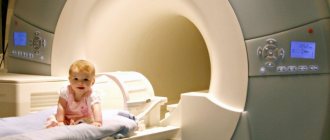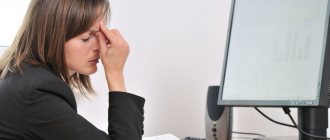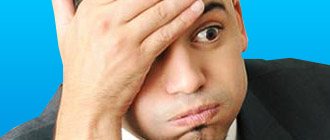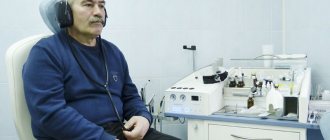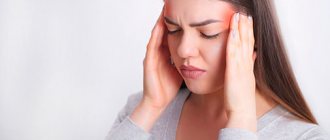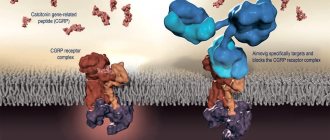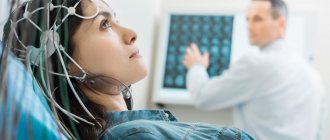Headache is one of the most common types of neurological disorders according to the World Health Organization. WHO statistics state that half of the world's adult population experiences an episode of headache at least once a year.
Despite its widespread prevalence, the pathology is often not treated properly: many patients prefer not to seek medical help, but to take available painkillers to temporarily numb the pain. But such a decision is dangerous because of its consequences: a headache may not be an independent disease, but a symptom of a serious neurological disorder. What types of headaches exist and which specialist should I contact for treatment?
Why does my head hurt?
Any discomfort that occurs in the body indicates the occurrence of pathological processes, and headaches are no exception. There are many reasons why discomfort occurs. Among the most common:
- violation of the tone of blood vessels supplying the brain;
- poisoning;
- infections;
- fever;
- traumatic brain injury (TBI);
- diseases of the spine.
A headache attack can be triggered by a disturbance in sleep patterns, a change in climate zone, or prolonged physical or intellectual overload. Even a single case of headache indicates some kind of disorder in the body, but if attacks occur regularly, it is recommended to make an appointment with a neurologist.
Headaches can be concomitant symptoms of other diseases: meningitis, sinusitis, sinusitis. If discomfort persists for a long time or is constantly repeated, the patient may have cardiovascular pathologies, kidney disease, or parasitic infestations. Sharp pain in the orbital area can be caused by glaucoma and eye abnormalities.
Only a specialist can determine the exact cause of headaches after examination and additional tests.
What other methods of migraine prevention exist and what actually works?
1. Migraine Diary
To avoid an attack, you need to know what triggers it. Different people have different triggers, so first you need to know yours.
To do this, your doctor may suggest keeping a migraine diary for a month. Such a diary can be a classic paper diary or in the form of an application on your phone (for example, Migraine Diary or Migraine coach); there is even a convenient Telegram bot that will help you track exactly when a migraine appears.
Typically, in a migraine diary, a person records the date of the attack, the events that preceded it, how the head hurt and what other symptoms were observed. The diary also records medications that helped or did not help relieve pain.
2. Psychotherapy
Stress is an important provocateur of headaches. Therefore, if a person learns to cope with it, there is a chance that the headache will hurt less. It’s great that the situation with attitudes towards psychotherapy in Russia is changing, and those who have undergone such treatment note that there are actually fewer attacks.
How microbiota fights stress and depression
3. Lifestyle changes
Maintaining a sleep schedule, a tasty and varied diet, sufficient physical activity, and avoiding alcohol will help alleviate migraines.
What types of headaches are there?
In neurology, the “International Classification of Headache Disorders” approved by WHO is used. According to the current classifier, there are 13 main groups of headaches, some of which are characterized as primary (that is, being an independent pathology), and some as secondary (occurring against the background of other diseases).
The cause of the primary headache can be:
- vascular in nature - caused by cerebral vascular dystonia and can be different: pulsating, aching, causing a feeling of squeezing and heaviness. Symptoms depend on the characteristics of the pathology: for example, if the venous outflow is impaired, the patient complains of a feeling of fullness, which intensifies when lying down;
- vertebrogenic – caused by spinal pathology, for example, cervical osteochondrosis. In this case, the curvature of the spinal column disrupts the normal nutrition of the brain, which becomes the cause of acute or aching pain;
- Tension headache is the most common type, which is described by patients as a feeling of pressure, a “hoop” or “helmet”. It can occur occasionally or regularly - in this case, neurologists talk about chronic pathology. Develops against the background of autonomic dysfunctions and constant stress;
- migraine - paroxysmal severe pain that appears on one side of the head. Often accompanied by sensitivity to light and smells, nausea, and vomiting. Usually occurs in young people under 35 years of age;
- trigeminal autonomic cephalgia, which includes, for example, cluster pain. It is characterized by sharp painful attacks that occur on one side of the head, alternating with periods of remission. As a rule, the attack is quite short and lasts a few seconds;
- cough - occurs against the background of coughing, sneezing or other physical stress associated with straining. It has a sharp cutting nature, lasts from several minutes to half an hour;
- developing after physical activity - appears exclusively after various exercises, training, running or heavy physical work
A separate classification exists for secondary headaches. According to it, pathology can develop against the background of infections (for example, meningitis), after traumatic brain injuries and neck injuries, with ENT diseases, mental disorders, and depression. A separate category includes headaches that appear from uncontrolled use of painkillers.
For effective treatment, it is necessary to establish the type and cause of the headache. This can be done during an examination by a qualified neurologist.
What is migraine
Migraine is an attack-like pain of severe or moderate severity. Typically, migraines cause pain in one part of the head. According to various sources, migraine is diagnosed in approximately every fifth person. Moreover, women suffer from it more often than men.
The disease can progress in different ways. Attacks can occur up to eight times a month or once every few years and last from 4 to 72 hours.
Typically, migraines begin at a young age and resolve spontaneously after age 50.
What types of migraine are there?
Migraine can be different, it depends on whether it has an aura or not. Migraine is divided into migraine with aura, migraine without aura and migraine aura without headache. In the latter case, the headache never develops.
An aura is a set of warning signs that occur shortly before a painful attack. Such precursors of migraine are noted by about 25% of patients.
In fact, an aura is the second phase of a migraine (there are 4 of them). It usually appears an hour before the attack. At this time, a person may complain of flashes, spots or spots before the eyes, numbness of the fingers, lips or tongue.
Often such symptoms are frightening, so the aura phase is also accompanied by anxiety. All signs of the aura disappear on average 20 minutes after the onset.
How is a migraine different from a headache?
Migraine is often called any headache, but this is a misconception. In fact, migraine is one of the types of headaches that has a number of distinctive features:
- pain is localized in one half of the head;
- has a sharp, often pulsating character;
- pain syndrome is accompanied by increased sensitivity to smells and light, as well as nausea, often vomiting;
- an attack rarely lasts longer than a day.
Often before a migraine, patients experience characteristic signs of developing pain: for example, short-term blurred vision, tingling in the fingertips. The disease is more often diagnosed in young people aged 18 to 35 years, women are more susceptible to migraines than men.
Despite the prevalence of migraine, neurologists have not fully established the cause of its occurrence. The main factors associated with the development of migraines:
- heredity;
- vascular pathologies of the brain;
- congenital abnormalities of brain tissue.
An attack can be triggered by stress, an unbalanced diet, lack of proper rest, or sudden intense physical activity. Migraine is one of the most severe headaches, temporarily depriving a person of his ability to work. To stop it, it is necessary to choose the right medications, as well as adhere to preventive measures developed by the observing neurologist.
4.Migraine treatment
Treatment of migraine includes symptomatic
, aimed at reducing the intensity and duration of pain, and
etiopathogenetic
, carried out to eliminate the causes of the disease.
The first is to relieve pain and eliminate nausea. It is recommended to keep a headache diary
. After each attack, it is necessary to remember the factors that occurred before each episode, to identify from the previous conditions those that could serve as triggers for the onset of migraine. Often, the onset of an attack occurs due to a combination of several circumstances (for example, a change in weather plus stress), while each of them individually is usually neutral.
Drug therapy
during a migraine attack may include a number of medications that are chosen only in conjunction with a doctor:
- serotonin antagonists;
- ergotamine;
- beta blockers;
- anticonvulsants;
- antidepressants.
In addition, the neuropsychic nature of migraine allows adjustments to be made using behavioral or body-oriented psychotherapy
. These types of psychotechnics are aimed at increasing stress resistance, stabilizing and normalizing affective response and general emotional status, preventing spasms of the head muscles, and improving blood flow in the vessels of the brain.
In general, practice shows that migraines sooner or later go into remission with age, especially when a person reaches old age, which is accompanied by a decrease in the production of sex hormones. However, headaches should not be neglected, since migraine sufferers are at higher risk of cardiovascular disease and stroke. During an attack, it is necessary to take symptomatic treatment and limit yourself in physical and mental activity so as not to provoke serious complications.
Why is it dangerous and does it need to be treated?
Even if you are faced with a single attack of mild headache, this indicates the presence of hidden disorders that can develop in the future and lead to various pathologies: for example, vascular disorders. But there are markers indicating that you should contact a neurologist immediately:
- the pain is sudden, intense, and difficult to bear;
- pain appeared after physical labor or sports training;
- you recently had a head injury (severe bruise, blow from a fall);
- headache increases with changes in body position;
- painful sensations are accompanied by other symptoms: blurred vision, numbness of the limbs, goosebumps, nausea, unfocused attention, fever.
An attack can be caused by a stroke, acute poisoning, oxygen starvation of brain cells, or infections. Therefore, it is necessary to make an appointment with a neurologist as soon as possible. The specialist will conduct an initial examination and prescribe additional examinations:
- Doppler ultrasound – ultrasound examination of the vessels of the neck and head. Allows the doctor to determine the volume of blood flow, detect fluid stagnation, assess the elasticity of the vascular walls, and so on. Vascular problems are one of the most common causes of frequent pain and dizziness;
- SCT (spiral computed tomography) is a non-invasive examination that allows you to assess the condition of the brain tissue and meninges, detect deviations from the norm, structural abnormalities, foci of inflammation, tumors, bleeding;
- MRI of the brain. Another non-invasive study, painless and safe for the patient. In the images, the neurologist can see pathologies, injuries, paroxysmal conditions, abnormal vasodilation and other abnormalities.
If the infectious nature of the disease is suspected, general tests may be prescribed: for example, urine and blood tests.
You should also consult a neurologist if you periodically suffer from headache attacks. The doctor will determine the causes of pain and select effective therapy to eliminate it.
Is migraine a treatable disease?
Unfortunately, it is impossible to completely cure migraines, but together with your doctor you can choose methods that will help control the disease, and perhaps even prevent new attacks.
But there is no doubt that it needs to be treated, because “tolerating it” is a bad prospect. If you do nothing at all, there is a risk of worsening the disease. This means your headache will hurt more often and more severely. Do not do it this way.
Here's what the UK National Health Service recommends regarding migraine treatment:
- Classic painkillers such as ibuprofen or paracetamol, as well as their combinations.
- Special drugs for the treatment of migraine (triptans). They not only suppress the headache, but disrupt the very mechanism of migraine formation.
Triptans should not be taken more than 9 days per month. This is dangerous due to the worsening of migraine and the occurrence of drug-induced headaches.
3. Antiemetic drugs. They help get rid of the feeling of nausea that often accompanies migraine attacks.
Many people find non-traditional methods of treating migraines helpful. For example, herbal teas, aromatherapy, baths, and also massage or osteopathy. Despite the fact that none of these methods are included in official recommendations, experts do not deny their possible therapeutic effect.
In addition to these drugs, injection therapy with monoclonal antibodies is increasingly being used to treat migraine. These drugs contain specific antibodies that block the CGRP protein (calcitonin gene-related peptide) or its receptor.
CGRP is one of the pain mediators that is responsible for the intensity of pain during an attack. The more it is released, the worse a person feels.
Monoclonal antibody drugs for the treatment of migraines block the activity of CGRP and prevent pain. This therapy is used in the case of chronic migraine, when attacks occur more than four times a month. Monoclonal antibody drugs help reduce the frequency of attacks. We can say that this is a kind of migraine prevention.
In addition, as a preventative measure, doctors advise reconsidering your lifestyle and adding some healthy habits.
It has been proven that people who are overweight, lack physical activity, and those who drink little water are more likely to suffer from migraine attacks.
Which doctor should I consult for treatment of migraines and headaches?
If you have episodic or regular headaches, you should consult a neurologist. In order for the doctor to quickly determine the nature of the pathology and establish its cause, be prepared to answer a number of questions:
- in which area of the head the discomfort is localized: in the forehead, in the temples, on the back of the head;
- what is the nature of the pain: pulsating, dull, sharp, migrating, etc.;
- how long ago it appeared and how often it repeats;
- is it accompanied by additional symptoms: sensitivity to light, smells, nausea;
- whether other family members suffer from headaches;
- Do you have a history of birth, traumatic brain injury, neuralgia, or previous neurological infections?
Patients may be advised to keep a special diary in which to record recurring episodes, their triggering factors, duration, and course characteristics. The neurologist may also ask about the daily routine, the nature of work, and lifestyle. After examination and receiving test results, the doctor will accurately determine the type and cause of pain and select the appropriate medicine.
The treatment is complex and is aimed both at relieving attacks of pain (with the help of various analgesics) and at eliminating the root cause of its occurrence. Much attention is paid to lifestyle correction.
Why do some people suffer from migraines and others don't?
It is impossible to answer this question accurately, because the mechanism of migraine occurrence is still poorly understood. . But over the past few years, scientists have made sufficient progress in this issue and have proven that migraine is inherited (if both parents suffer from this disease, then children will have it with a probability of more than 60%) and arises as a result of a combination of genetic factors, environmental factors environment and lifestyle.
Most of the genes that are associated with migraine are active in the muscles surrounding blood vessels and regulate their constriction/dilation.
Is it possible to get rid of headaches using traditional medicine?
Many patients faced with recurrent headaches are in no hurry to consult a neurologist and try to recover with the help of traditional medicine. However, this approach does not lead to a positive result: any self-medication is dangerous. This is due to a number of reasons:
- uncontrolled use of painkillers (even of herbal origin) can lead to serious side effects: disruption of the liver and kidneys, allergic reactions, problems with the gastrointestinal tract. This will not only not relieve neurological disorders, but will also lead to the development of new pathologies;
- The cause of the headache can only be determined after a series of medical examinations. Without this, any therapy comes down to masking the symptoms, while the pathology causing the headache continues to develop.
Therefore, you should not postpone your visit to the doctor and rely on traditional medicine. But patients can actually take some actions that will reduce the frequency of relapses and relieve headache attacks. We are talking about developing healthy lifestyle habits:
- regular physical activity. One of the common causes of headaches is physical inactivity, as a result of which the tone of muscles and blood vessels decreases, the blood supply to the brain tissue deteriorates, and degenerative processes begin. Sports and exercise help strengthen the body and reduce the risk of chronic headaches;
- balanced and varied diet. It is recommended to exclude fast food, fatty, smoked and salty foods from the diet, eat more vegetables and fruits, replace white bread with rye bread or baked goods with bran. A properly selected diet is a good prevention of vitamin deficiencies; it also prevents excess fluid from accumulating in the body, which can increase intracranial pressure and lead to migraines;
- full 8-hour sleep. During sleep, the body recovers and “gets rid” of psycho-emotional stress. Regular lack of sleep undermines a person’s immunity, increases stress levels, and leads to cerebral vascular spasms;
- correct drinking regime. Necessary for maintaining a healthy water-salt balance in the body. Doctors usually recommend drinking up to 2 liters of clean drinking water per day (not counting liquid obtained with other products). During hard physical work, intense physical activity, and in hot weather, the amount of water consumed should be increased;
- regular walks in the fresh air (from 1 hour a day). While walking in parks and forested areas, the body receives the missing physical activity, the blood is saturated with oxygen. This is also important for preventing headaches.
3.Factors that may influence the development of the disease
Mechanism of migraine development
, apparently, consists of a disorder of the central nervous system, which triggers a chain of certain neurological and biochemical changes that affect the functioning of the blood vessels of the brain. Hereditary factors that determine the functioning of the nervous and cardiovascular systems are also considered significant. In addition, the role of neurotransmitters and uncontrolled long-term tension of the facial, neck and shoulder muscles has been suggested.
The trigger for the onset of migraine development can be a variety of factors:
- excitement (negatively or positively colored);
- changes in the weather;
- interruptions in nutrition and sleep;
- strong odors, sounds, insufficient, too bright or flickering lighting, other unfavorable conditions affecting the senses;
- physical exercise;
- physiological events (vomiting, persistent cough of any origin, sexual activity or dissatisfaction, menstruation);
- some foods (to identify them, it is recommended to keep a diary of food intake and migraines).
About our clinic Chistye Prudy metro station Medintercom page!
Is it possible to get rid of headaches and migraines? It is expensive?
If you consult a neurologist in a timely manner, you can completely get rid of headaches. The doctor will select drug therapy and develop preventive recommendations to prevent relapse.
To fully recover, you will need:
- follow medical instructions;
- normalize work and rest schedules;
- get rid of the causes of headaches (concomitant diseases);
- lead an active and healthy lifestyle.
Your health is in your hands! There is no need to think that recovery is expensive. Much of your success depends on how willing you are to change your life for the better and follow your doctor's orders.
1
0
0
Article rating:
5 out of 5 based on 1 rating
Author: Atamanenko Alena Valerievna
General practitioner, endocrinologist, physiotherapist. Second category. Work experience more than 9 years.
On a note
- Every fifth person on the planet suffers from migraines. More often these are women.
- The disease manifests itself between the ages of 20 and 50 years.
- It is not difficult to determine that a person has migraine.
- Hormonal changes, alcohol, stress and other factors affect the frequency of attacks.
- Migraine is hereditary.
- Migraines cannot be completely cured, but they can be controlled.
- For treatment, classical painkillers, triptans, and monoclonal antibodies are used.
- Lifestyle affects the frequency of attacks.
- Physical exercise, a varied diet, and maintaining a sleep schedule - all this helps to suffer from migraines less often.
- A migraine diary will help you find individual triggers for the disease.
Genes largely determine whether a person will have migraines or not. You can find out about your predisposition to diseases, including migraines, with the Atlas Genetic Test.
Sources:
- Ashina M, Katsarava Z, Do TP, Buse DC, Pozo-Rosich P, Özge A, Krymchantowski AV, Lebedeva ER, Ravishankar K, Yu S, Sacco S, Ashina S, Younis S, Steiner TJ, Lipton RB. Migraine: epidemiology and systems of care. Lancet. 2021
- Charles A, Pozo-Rosich P. Targeting calcitonin gene-related peptide: a new era in migraine therapy. Lancet. 2019
- Mayo Clinic. Migraine care at Mayo Clinic. 2021
- Ivan Garza, Todd J Schwedt. Chronic migraine. 2020
- F Michael Cutrer. Pathophysiology, clinical manifestations, and diagnosis of migraine in adults. 2020
- American migraine foundation. Anti-CGRP Migraine Treatments: Your Questions Answered. 2018
- NHS. Migraine.Overview. 2019
Preventing migraine attacks
To reduce the frequency and intensity of migraine attacks, doctors recommend:
- avoid stressful situations if possible;
- maintain a healthy sleep schedule, sleep in a dark and quiet room;
- give up foods that can provoke an attack (or at least reduce their quantity) - chocolate, baked goods, red wine, large amounts of coffee;
- follow a diet and drinking regime - try not to go hungry and drink enough clean, still water;
- add ginger and cayenne pepper to food in moderation;
- use medicinal plants - lavender (lotions) and mint (lotions, decoctions for oral administration).
Many people suffering from migraines are helped to reduce the frequency and intensity of attacks by compresses from ice packs, cold hand baths, massages (acupressure or collar area and head) - but all these measures must be selected purely individually.
In addition, it is recommended to take magnesium and vitamins B6 and B2 - they can be taken both as mono supplements and as part of mineral-multivitamin complexes. Of course, you should take any dietary supplements for migraines only after consulting your doctor.
Liki24.com targeted medicine delivery service wishes you good health!
Causes of migraine
As already mentioned, migraine is a hereditary disease. Moreover, according to statistics, women suffer from it three times more often than men. Some modern researchers tend to see this as a connection with the hormones of the menstrual cycle, in the last phase of which the levels of certain hormones (progesterone, estrogen) drop in the female body - they say, this can provoke attacks. However, there is also a theory that women simply visit doctors more often for headaches, and therefore are more often diagnosed with migraine.
According to WHO, migraine usually begins simultaneously with puberty, causing the most severe suffering in 35-45 year old people. In any case, the disease recedes with age - due to both hormonal changes and a decrease in the elasticity of blood vessels.
In principle, migraine began to be studied in detail relatively recently - only in 1960. Before that, it was considered the lot of anxious people, a kind of mental disorder. Methysergide entered the pharmaceutical market, the disease was transferred to the category of physiological and began to be studied in more detail.
At the moment, it is known that migraine is directly related to mutations of certain genes - they provoke hyperactivity of brain neurons and excessive excitation in its areas responsible for processing sensory information (light, sound). Seizures can be caused by external stimuli - triggers , for example:
- lack of sleep (or excess);
- stress (and sometimes relaxation after stress);
- hunger, thirst;
- certain foods: chocolate, sugar, cheese, meat, salty foods, sometimes coffee (although in some cases coffee, on the contrary, helps relieve a migraine attack);
- alcoholic drinks;
- strong smells, sounds, light;
- excessive physical activity;
- climate and/or weather changes, etc.
It has also been proven that the development of chronic migraine can be associated with excess weight, depression, anxiety, certain diseases (for example, hypothyroidism), as well as uncontrolled and too frequent use of headache medications .

